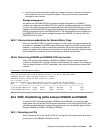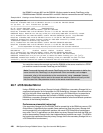
428 IBM System Storage DS6000 Series: Copy Services with IBM System z
the DS8000 to volume 0601 on the DS6000. We then created a remote FlashCopy on the
DS6000 between DS6000 volumes 0601 and 0602. We then removed the remote FlashCopy.
Example 28-12 Creating a remote FlashCopy where the DS6000 is the remote target
dscli> lspprcpath 08
Date/Time: 9 November 2005 3:01:10 IBM DSCLI Version: 5.1.0.204 DS: IBM.2107-7503461
Src Tgt State SS Port Attached Port Tgt WWNN
=========================================================
08 06 Success 6000 I0001 I0103 500507630EFFFE16
ddscli> mkpprc -remotedev IBM.1750-1300247 -type mmir 0801:0601
Date/Time: 9 November 2005 3:02:36 IBM DSCLI Version: 5.1.0.204 DS: IBM.2107-7503461
CMUC00153I mkpprc: Remote Mirror and Copy volume pair relationship 0801:0601 successfully created.
dscli> mkremoteflash -dev IBM.1750-1300247 -conduit IBM.2107-7503461/08 -persist -nocp 0601:0602
Date/Time: 3 November 2005 22:35:45 IBM DSCLI Version: 5.1.0.204 DS: IBM.1750-1300247
CMUC00173I mkremoteflash: Remote FlashCopy volume pair 0601:0602 successfully created. Use the
lsremoteflash command to determine copy completion.
dscli> lsremoteflash -dev IBM.1750-1300247 -conduit IBM.2107-7503461/08 0601:0602
Date/Time: 9 November 2005 3:04:07 IBM DSCLI Version: 5.1.0.204 DS: IBM.1750-1300247
ID SrcLSS SequenceNum ActiveCopy Recording Persistent Revertible SourceWriteEnabled
===========================================================================================================
0601:0602 06 0 Disabled Enabled Enabled Disabled Enabled
dscli> rmremoteflash -dev IBM.1750-1300247 -conduit IBM.2107-7503461/08 0601:0602
Date/Time: 3 November 2005 22:36:19 IBM DSCLI Version: 5.1.0.204 DS: IBM.1750-1300247
CMUC00179I rmremoteflash: Are you sure you want to remove the remote FlashCopy pair {0}? [y/n]:y
CMUC00180I rmremoteflash: Removal of the remote FlashCopy volume pair 0601:0602 has been initiated
successfully. Use the lsremoteflash command to determine when the relationship is deleted.
You could also reverse the scenario and use the DS6000 as the source machine in a PPRC
pair and then create the remote FlashCopy on the DS8000.
28.7 z/OS Global Mirror
Using a DS8000 as the primary Storage Unit and a DS6000 as a secondary Storage Unit is a
supported configuration for the purposes of z/OS Global Mirror. However, the authors did not
test it for this book. More importantly, if you plan to use z/OS Global Mirror, be aware that a
z/OS Global Mirror environment that includes a DS8000 as a primary Storage Unit and a
DS6000 as a secondary Storage Unit is not recommended for failover and failback operations
because of the following limitations.
Performance mismatch (mirroring)
If the secondary Storage Unit, the DS6000, and its connectivity to the SDM that runs on z/OS
Global Mirror, is significantly less capable (lower performing) than the primary Storage Unit
and its connectivity to the application systems, the overall z/OS Global Mirror performance
may suffer. That is, if applications can write faster to primary Storage Units than the SDM can
write to the secondary Storage Units, then implementations problems can result. (The SDM is
the function that copies data from the primary Storage Unit to the secondary Storage Unit in a
z/OS Global Mirror environment.)
Note: Commands that work with remote FlashCopies use the -dev parameter to define the
server on which the FlashCopy is to be performed. Other commands, such as mkpprc
commands, refer to this same device as the remote device, using -remotedev. However,
because a FlashCopy must be sent to the remote site and then performed locally on that
site, the use of the -dev parameter to refer to the remote machine is correct.


















